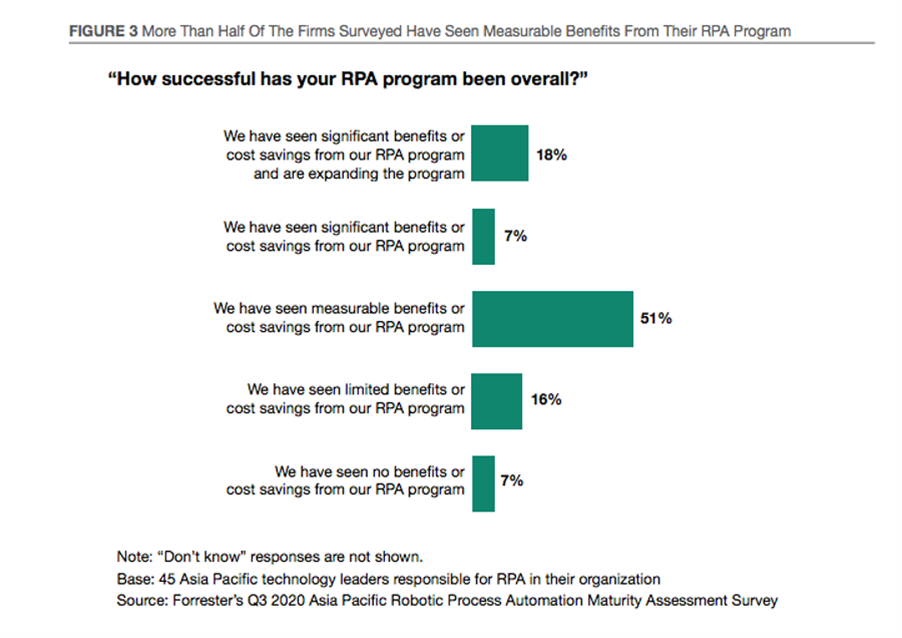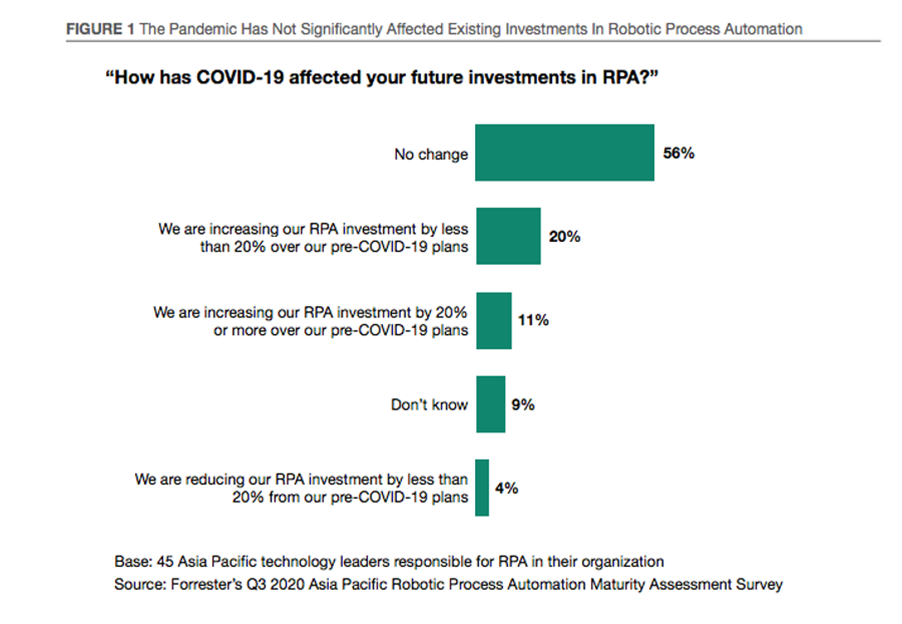The Asia Pacific region and markets have been growth engines for robotic process automation (RPA) in recent years, with firms both large and small now showing greater interest in automation, particularly in the aftermath of the pandemic, a survey by Forrester Research found.
The survey, released February last month, polled 45 companies in the region, found three types of companies driving RPA demand.

The first comprises offshore captives running scaled-out global automation hubs. Particularly in India and the Philippines, the offshore captive entities of large global corporations have created significant scale in automation.
Many were able to adopt automation as a fresh charter and become “robotic hubs” or automation competency centres for their parent entity and its global business units.
Second were first-wave adopters who have seen early success but struggle with scale. These enterprises serve country or regional markets and started their RPA journey within the past three years.
The third, second-wave adopters, are setting new expectations from the market. Such firms represent the newer wave of participants in the automation market; they started their RPA journey within the past 12 to 18 months. These firms often struggle to establish the value and cadence of business automation.

Importance of RPA
Speaking with iTNews Asia about the importance of automation in the tech sector, Leslie Joseph, the author of the report and principal analyst at Forrester describes RPA as a collection of software tools and processes that mimic and integrate human interactions with digital systems to execute a business process in an automated fashion just like a human would.
Joseph explains that RPA can automate routine, repetitive tasks across business functions by deploying ’software bots’ to perform these tasks instead of humans. This allows companies to reduce reliance on manpower, or to shift human effort to higher-level skills and tasks.
“Using software bots also allows businesses to eliminate rework or cost associated with human error in processes. Companies that have deployed RPA have been able to keep processes running even when the human workers tasked with running these processes were not able to get to work.
“This has made RPA a tool for mitigating enterprise risk and maintaining business continuity through the pandemic.”
Key takeaways from the RPA survey
Some of the key observations include
- COVID-19 has not created significant automation impetus
Over half of our respondents felt COVID-19 has not affected their future RPA investments Many firms in APAC firms took a while to stabilise in the first phase of the pandemic, after which COVID-19 and the resulting environment of uncertainty and cost pressure pushed them to try automation for the first time.
In contrast, companies that had already invested in a digital workforce were already realising adequate levels of risk mitigation and did not see a need to significantly increase automation investments.

OCBC Bank uses digital workers to adjust and process digital applications, such as home loans, within a minute, down from 45 minutes
- The cost/benefit equation in Asia Pacific is nuanced
The cost of labour in many APAC markets is lower than in North America and Europe, so the cost/benefit ratio of automation-induced labour arbitrage was not always immediately evident in early days of RPA. Over time, license discounting by vendors has improved the proposition.
Companies have also realised improvements aside from raw costs, such as faster service; Singapore’s OCBC Bank uses digital workers to adjust and process home loans within a minute — down from 45 minutes before.
- Employee productivity and cost savings still dominate the conversation
Most firms rate employee productivity benefits and the associated cost savings highly in terms of their goals for automation. However, few companies have improved business agility and flexibility. Many grapple with early-stage challenges such as identifying processes, navigating internal organisational challenges, and acquiring skilled technical talent.
- Automation-fueled transformation remains elusive
Across APAC, the use of automation remains largely an efficiency and cost takeout play rather than a transformation play. Counterexamples do exist, such as Singapore’s Marina Bay Sands Hotel, which uses RPA in conjunction with RFID and physical robotics to enhance the guest experience.










